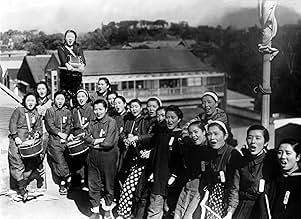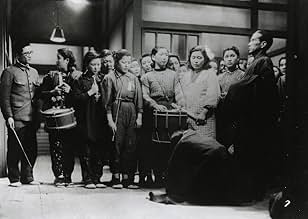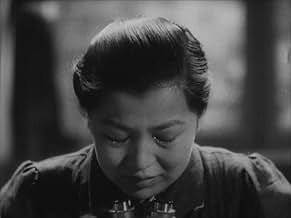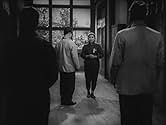AVALIAÇÃO DA IMDb
5,6/10
2,6 mil
SUA AVALIAÇÃO
Adicionar um enredo no seu idiomaWorld War II film about female volunteer workers at an optics plant who do their best to meet production targets.World War II film about female volunteer workers at an optics plant who do their best to meet production targets.World War II film about female volunteer workers at an optics plant who do their best to meet production targets.
Avaliações em destaque
Propaganda films are usually of interest to me because of the situation and time period they were made in and their point of view not because of plot or sublime character development. Rarely do the characterizations, I currently cannot think of one, go beyond one or two dimensions. This is because the point of the propaganda film regardless of origin is to rally the troops and align their sense of duty. This movie is no different in that regard. But there are several key differences from the typical propaganda film that makes this film more interesting. The most interesting approach was the documentary approach Kurosawa took. Though he used actresses he did all he could to remove the artificiality of their craft to create a realistic portrait of the young girls at that time who were working in military construction. I felt this movie was effective in that regard. The tempered acting to those that are used to the Noh influenced acting of his later films. Another surprise is that this is one of two films of Kurosawa where the protagonist is a woman. The other one is No Regrets For Our Youth (1946) with Setsuko Hara.
The least interesting aspect of the film is the story. It is about a group of young women in an optical instrument factory that have to push up production to fill the need for the optical lens. While the men were asked to increase their production a hundred percent, the women were asked to do 50 percent. This insulted the women and they asked that they do a more respectable number like 66 percent (would a higher number have been insulting to the men?). The hardships created by this are numerable as the women face sickness, injury, mental breakdown and general crabbiness.
The movie is too episodic and heavy on the "team spirit" motif (not that Kurosawa had much of a choice), but it eventually settles on the titular protagonist in Tsuru Watanabe (Yoko Yaguchi) who embodies the spirit (kokoro) of an ideal worker. Her mother is dying, but her father and her mother want her to stay in the factory working so that Japan will not lose face. What is subversive is that she is a stubborn individualist. When she loses track of lens that she did not finish correcting, she goes through the monument task of finding it, and regardless of the pain it causes her, the lack of sleep and her supervisors telling her she does not need to do it – she does it anyways.
I do not agree with Donald Richie in his The Films of Akira Kurosawa when he states "Twenty years later it is almost impossible for us to think a lost lens this important." She states that she worries that lost lens might result in the death of Japanese soldiers (and possibly in her mind a battle and ultimately the war). It does not matter if she is correct in this thinking, it only matters that she feels that way. Anyone who has any degree of OCD can relate to this. Once the mind gets fixed with an idea that may haunt them it is easy to understand the monomania which consumes her until she finds her mistake.
One thing that surprised me when hearing it in the film, and the fact that Kurosawa got away with putting into the score (he mentions this in his autobiography), is the insertion of "Semper Fidelis" by John Philip Sousa.
Has anyone seen any other Kurosawa film where he uses as many horizontal wipes? After the picture he married the main actress Yoko Yaguchi. It was love at first sight. Kurosawa stated "She was a terribly stubborn and uncompromising person, and since I am very much the same, we often clashed head on." I do wonder how well they got along over the years though.
I think this film can satisfy not only Akira Kurosawa fans but fans of social realist cinema and of course those looking for propaganda films of WWII. If someone is just getting into Japanese cinema this probably could be passed on for quite a long awhile. But for completists (those reading this) they will want to see this. But then again completists want to see everything.
The least interesting aspect of the film is the story. It is about a group of young women in an optical instrument factory that have to push up production to fill the need for the optical lens. While the men were asked to increase their production a hundred percent, the women were asked to do 50 percent. This insulted the women and they asked that they do a more respectable number like 66 percent (would a higher number have been insulting to the men?). The hardships created by this are numerable as the women face sickness, injury, mental breakdown and general crabbiness.
The movie is too episodic and heavy on the "team spirit" motif (not that Kurosawa had much of a choice), but it eventually settles on the titular protagonist in Tsuru Watanabe (Yoko Yaguchi) who embodies the spirit (kokoro) of an ideal worker. Her mother is dying, but her father and her mother want her to stay in the factory working so that Japan will not lose face. What is subversive is that she is a stubborn individualist. When she loses track of lens that she did not finish correcting, she goes through the monument task of finding it, and regardless of the pain it causes her, the lack of sleep and her supervisors telling her she does not need to do it – she does it anyways.
I do not agree with Donald Richie in his The Films of Akira Kurosawa when he states "Twenty years later it is almost impossible for us to think a lost lens this important." She states that she worries that lost lens might result in the death of Japanese soldiers (and possibly in her mind a battle and ultimately the war). It does not matter if she is correct in this thinking, it only matters that she feels that way. Anyone who has any degree of OCD can relate to this. Once the mind gets fixed with an idea that may haunt them it is easy to understand the monomania which consumes her until she finds her mistake.
One thing that surprised me when hearing it in the film, and the fact that Kurosawa got away with putting into the score (he mentions this in his autobiography), is the insertion of "Semper Fidelis" by John Philip Sousa.
Has anyone seen any other Kurosawa film where he uses as many horizontal wipes? After the picture he married the main actress Yoko Yaguchi. It was love at first sight. Kurosawa stated "She was a terribly stubborn and uncompromising person, and since I am very much the same, we often clashed head on." I do wonder how well they got along over the years though.
I think this film can satisfy not only Akira Kurosawa fans but fans of social realist cinema and of course those looking for propaganda films of WWII. If someone is just getting into Japanese cinema this probably could be passed on for quite a long awhile. But for completists (those reading this) they will want to see this. But then again completists want to see everything.
A curious film from Kurosawa, given what came later, this is a nationalist film about a group of young women who are working at an optical instruments factory who are given the task to greatly increase productivity for the good of the country and the war effort. It shows them rarely at play, mostly very focused at work. Takako Irie plays the dorm mother, a somewhat sympathetic character. This film is more inherently Japanese than most of Kurosawa's later work, its almost a propaganda film. However, there is also some heart in the characters, and that is what makes it a recommended film. You sense the young ladies anguish over being sick and having family difficulties, making them unable to work. So, not essential viewing but still watchable and Kurosawa fans should check it out.
10matt605
If you study this film then you can learn much about Japan, World War Two, and Akira Kurosawa. This is the only film he made that was meant to be propaganda, but his earlier film Sanshiro Sugata actually played to themes more useful to a nation at war. If you make a film that matches the zeitgeist of your country, that's great. But be forewarned that your country's government may then ask you to inspire the people to fight on, and you would then make a propaganda film, which is what may have happened to Kurosawa. This fact shouldn't make you reject The Most Beautiful because cinema in all countries in WW2 was used in the war effort. Japan was no exception.
Kurosawa in interviews after the war revealed his dislike of the government censors. Toward the end of the war, Japanese were preparing for the possibility of the entire nation receiving an order from the Emporer to commit suicide, called "the Honorable Death of the 100 Million." Kurosawa didn't dispute that he would have followed the Emporer's directive, but did say that he and his colleagues jokingly agreed they would first go and kill all the censors.
The plot and action of the film is described elsewhere. There are things to watch for carefully as you view the film.
If you're in a university setting then there is one absolute advantage that you have -- access to a professor of management and organizational behavior. Why? Well, The Most Beautiful is practically a docu-drama on management science. The scientific methods of production and organizational management are more clearly documented in this film than in any other I can recall, anywhere. It also compares things like Stakhanovism to Hawthorne experiment studies and displays the early beginnings of total quality management and quality assurance methods later developed by Deming. If these terms are unfamiliar to you, then you need a professor of management science to watch the film and help you see what Kurosawa was putting in. Then consider that the film was released to the Japanese public, which assured that it would be viewed by American military intelligence organizations and the OSS.
Some specifics to look for in no particular order: the background music includes a sampling from Semper Fi, the USMC theme song; there's little talk of enemies but when they're mentioned, the British are named ahead of Americans; the factory managers back a young woman's rejection of her father's instruction to come home and take the place of his deceased wife, which is a break with tradition (almost the equivalent of bra-burning in wartime Japan); and, backgrounds are set in wartime Japan and reveal details of the industrial infrastructure.
There are many films by Kurosawa that feature sickness and health care in their plots. This one, Drunken Angel, Ikuru, The Quiet Duel, and Red Beard come to mind. Dodes' ka-den and Ran might also qualify as their main characters suffer from afflictions of the mind. Kurosawa's biggest films are Rashomon and The Seven Samurai, but his films with health and medicine in the plot are more prevalent in his career.
One caveat to The Most Beautiful is that it is long and does reflect the tastes of Japanese audiences who like their drama very obvious. Forgive yourself if you find Japanese drama becomes too boring in some places. The films can be very enjoyable and interesting, provided you approach them with the understanding that they are far different from what we experience as entertainment today.
Kurosawa in interviews after the war revealed his dislike of the government censors. Toward the end of the war, Japanese were preparing for the possibility of the entire nation receiving an order from the Emporer to commit suicide, called "the Honorable Death of the 100 Million." Kurosawa didn't dispute that he would have followed the Emporer's directive, but did say that he and his colleagues jokingly agreed they would first go and kill all the censors.
The plot and action of the film is described elsewhere. There are things to watch for carefully as you view the film.
If you're in a university setting then there is one absolute advantage that you have -- access to a professor of management and organizational behavior. Why? Well, The Most Beautiful is practically a docu-drama on management science. The scientific methods of production and organizational management are more clearly documented in this film than in any other I can recall, anywhere. It also compares things like Stakhanovism to Hawthorne experiment studies and displays the early beginnings of total quality management and quality assurance methods later developed by Deming. If these terms are unfamiliar to you, then you need a professor of management science to watch the film and help you see what Kurosawa was putting in. Then consider that the film was released to the Japanese public, which assured that it would be viewed by American military intelligence organizations and the OSS.
Some specifics to look for in no particular order: the background music includes a sampling from Semper Fi, the USMC theme song; there's little talk of enemies but when they're mentioned, the British are named ahead of Americans; the factory managers back a young woman's rejection of her father's instruction to come home and take the place of his deceased wife, which is a break with tradition (almost the equivalent of bra-burning in wartime Japan); and, backgrounds are set in wartime Japan and reveal details of the industrial infrastructure.
There are many films by Kurosawa that feature sickness and health care in their plots. This one, Drunken Angel, Ikuru, The Quiet Duel, and Red Beard come to mind. Dodes' ka-den and Ran might also qualify as their main characters suffer from afflictions of the mind. Kurosawa's biggest films are Rashomon and The Seven Samurai, but his films with health and medicine in the plot are more prevalent in his career.
One caveat to The Most Beautiful is that it is long and does reflect the tastes of Japanese audiences who like their drama very obvious. Forgive yourself if you find Japanese drama becomes too boring in some places. The films can be very enjoyable and interesting, provided you approach them with the understanding that they are far different from what we experience as entertainment today.
This is a great movie - a must-see. I saw it without subtitles, and my Japanese wasn't good enough to catch most of the dialog, but the raw emotional power of the cast and of the imagery made it easy to follow - completely engrossing, in fact. The story is about a group of women factory workers in WWII Japan, and how each one must overcome whatever personal hardship they face to help the group succeed. The sense of being swept up in a titanic struggle, and the almost superhuman selflessness and group cohesion that that breeds, are the same themes treated in "Twelve-O'clock High". The two movies would make an enlightening double feature. One image sticks with me: although it's not focused on, throughout the movie you see the women carefully taking off their shoes and placing them neatly by the door as they come in to the dormitory, and you see them carefully put them on as they leave. During one scene, when a girl is returning from the hospital, everyone rushes to greet her. Kurosawa cuts to a shot of the shoes, as they are thoughtlessly trampled by the women eager to meet their friend.
Typical of Japanese war-time propaganda, the film suggests that Japan's fascist ideology, its inculcation of fanatical obedience, its vast perpetration of unthinkable atrocities in a systematic manner, and its aggressive military expansionism can all be replaced by Japan's supposed victimization. Rather telling in this respect is the song that the girls repeatedly sing to boost morale, a song that recalls that barbarian Mongol conquerors once tried to invade Japan from China, but that the perpetrators of such heinous deeds of aggression could not possibly co-exist under the same sky with the innocent and pure Japanese-- this, of course, is being sung during a war that was begun when an utterly unprovoked Japan invaded China and slaughtered untold numbers of its population mercilessly.
All of this would be something that one could simply shrug off as the past blindness of war, but films such as these are more disturbing today than, say, Triumph of the Will because while Germany was forced to confront the horrors it had unleashed upon the world, most Japanese films even today (and textbooks for that matter) still tend to view Japan as a victim in the war (see, for instance, Kurosawa's own Rhapsody in August so many decades later). Assisted by the policies of the American post-war occupation, Japan has never had to come to terms with what it did to the planet, and what in human history can possibly more disturbing than a lack of accountability for the worst sins humanity can commit? And by the way, I say all of this despite the fact that Kurosawa is probably my favorite director.
All of this would be something that one could simply shrug off as the past blindness of war, but films such as these are more disturbing today than, say, Triumph of the Will because while Germany was forced to confront the horrors it had unleashed upon the world, most Japanese films even today (and textbooks for that matter) still tend to view Japan as a victim in the war (see, for instance, Kurosawa's own Rhapsody in August so many decades later). Assisted by the policies of the American post-war occupation, Japan has never had to come to terms with what it did to the planet, and what in human history can possibly more disturbing than a lack of accountability for the worst sins humanity can commit? And by the way, I say all of this despite the fact that Kurosawa is probably my favorite director.
Você sabia?
- CuriosidadesIn order to save film during wartime, the Japanese government ordered films to be released to have no opening titles and thus giving no credit to most of the actors or workers on each film. This included "The Most Beautiful" (1944).
- ConexõesReferenced in Kurosawa: The Last Emperor (1999)
Principais escolhas
Faça login para avaliar e ver a lista de recomendações personalizadas
- How long is The Most Beautiful?Fornecido pela Alexa
Detalhes
- Tempo de duração1 hora 25 minutos
- Cor
- Mixagem de som
- Proporção
- 1.37 : 1
Contribua para esta página
Sugerir uma alteração ou adicionar conteúdo ausente

Principal brecha
By what name was A Mais Bela (1944) officially released in Canada in English?
Responda




























